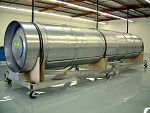Interview*
with Elon Musk
Founder
and CEO of Space Explorations Technologies Corp. (SpaceX)
*
via email
|
By
2001 the prospects for private development of orbital launch
systems
looked very
grim following the failures of several
highly promising companies. The bankruptcies of Iridium, Globalstar
and other comsat constellation projects had destroyed their
targeted market and seemed to indicate that there was
little to motivate new attempts to develop low cost launchers
for many years ahead.
Then in mid-2002
there came the surprising news that Elon Musk had started
a company to develop a two stage partially reusable launcher
that would
begin flying
within just a couple of years. The very successful internet
entrepreneur had founded Space Exploration Technologies Corp.,
or SpaceX for
short, to develop the launcher from scratch. The company has
shown steady progress since then and has constructed
and tested a great deal of hardware. The company plans to fly
its Falcon vehicle
for
the
first
time
this
coming
January.
|
 Credits:
SpaceX
Credits:
SpaceX
Artist view of the SpaceX Falcon
launcher now in development.
First launch is scheduled for early 2004. |
|
The Falcon will place
1400lb in low earth orbit for a mere $6 million. The company
has paying customers signed up for both the maiden flight and a second
launch and is said to be in negotiations to fly several other spacecraft.
The small
payload
market
has
not grown as expected a few years ago but with a launch price at a third
to a fourth of what competing vehicles charge, the Falcon will test the
theory that only high launch costs are holding back a great wave of small
sats projects.
Elon Musk brings
substantial resources to SpaceX and also impressive credibility
for successful business development. He co-founded the
enterprise software company Zip2 in 1995 and sold it to Compaq at
a substantial premium in 1999. He
then co-founded PayPal, which was sold to eBay in 2002
for
another highly profitable sum.
I contacted Elon
via email to discuss the background and status of SpaceX. The following
is that interaction assembled into a conversational interview format.
[Note: I've added links to some of the items that Elon discusses.
Indented sections are from the second round of questions.]
|
|
HS:
Private
rocket development by startup companies in the post-Apollo
era includes projects such as Truax's Volksrocket in the late
70s, Conestoga
I and AMROC in the 80s, Beal
Aerospace and several other ELV and RLV
companies in the
1990s. They all came up short of space and many see
their history as nothing but a tale of woe and failure. To me,
though, they each appear to build on what was
learned before them and to provide significant
advancements in the technical and strategic knowledge needed
to develop a rocket business from scratch.
It
looks like SpaceX will be the startup company that finally
makes it to orbit. When you studied prior efforts,
what were some of the lessons [you] learned
on what to do and, perhaps most importantly, what not to do?
|
Musk: :
Well, I have tried to learn as much as possible from prior attempts.
If nothing else, we are committed to failing in a new way :)
The ones I'm familiar
with failed on one or more of the following:
- Lacked a critical
mass of technical skill.
- Insufficient
capital to reach the finish line, particularly if an unexpected
setback occurred.
- Success was
reliant on a series of technology breakthroughs that did not
happen.
The above modes
can obviously cross-feed one another.
HS:
John
Carmack has said something to the effect that the gap between
what could be done versus what is being done is
bigger in aerospace than in any other
industry. Gary Hudson said that he was "amazed by how much
easier the job of getting
to orbit is today than even a few years go"..."Software,
avionics and manufacturing
technology have all improved measurably" and drastically
reduced the number of
people needed to design a launcher.
Now
that you've gone through the rocket vehicle design phase
and are
well into
construction, does your experience support their views or
has the Falcon development perhaps been more difficult than you initially
expected?
|
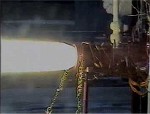
Credits:
SpaceX
SpaceX
recently test
fired their second stage engine, named
Kestrel.
|
|
Musk: Well,
hard and easy are somewhat nebulous terms. I think I have high
standards and would classify getting Falcon to orbit as quite difficult.
Overall though, I think we have had quite a smooth development
so far, which is a credit to the hard work of the SpaceX engineering
team.
The design tools,
such as solid modeling and finite element analysis software are
substantially more powerful than ten years ago, so that's a clear
advantage. Obviously, most electronics have improved a lot too,
except gyroscopes and flight termination systems.
HS:
Can
you think of any example where "standard practice" in the
design and construction
of launch vehicles is blatantly more expensive that the way you
guys did it with the Falcon?
Musk: It's
hard for me to comment definitively on "standard practice",
as I have never worked for another aerospace company. However,
based on stories I've heard, some of them sound like a Dilbert
cartoon in real life. My approach is simply to seek out very talented
people, ensure that the environment at SpaceX is as motivating & enjoyable
as possible and establish clear & measurable objectives.
I think it is
a mistake to hire huge numbers of people to get a complicated job
done. Numbers will never compensate for talent in getting the right
answer (two people who don't know something are no better than
one), will tend to slow down progress and will make the task incredibly
expensive. Also, a lot of aerospace senior managers seem to be
really disassociated from and unable to do hard core engineering.
I think that is a mistake and results in cloudy judgment on important
technical issues -- they can't tell if something is really good
or not, so they just do what everyone else does, assuming it to
be the safe bet.
HS: If
you had simply put the Falcon out to bid with the majors and let
one of them build it, how much might a launch cost?
Musk: Probably
something like $15M to $20M, although that is quite a random guess.
Right now, the two cheapest commercial American LVs are Pegasus and
Taurus. Their NASA list prices are $30M and $50M respectively, although
rumor has it that they cost about 25% less when bought directly from
Orbital.
HS: By
the way, someone pointed out to me that the latest figures
released for
the Falcon indicate 1400lbs to LEO. That's 400 more
than the number that was mentioned in previous articles.
Did something turn out to provide higher performance or weigh less than expected?
Musk: Our
original target was at least 1000lbs to nominal reference orbit (200km,
28.5, circular), but we had a very big sandbag in there. As the actually
engine and mass numbers are coming in, we are gradually reducing
the sandbag. Some publications are still reporting old numbers for
Falcon. Whatever number you see for [the standard] Falcon, heavy
Falcon will do slightly more than 3X.
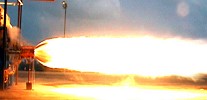 Credits:
SpaceX
Test
firing of the Falcon first stage engine, named Merlin.
Credits:
SpaceX
Test
firing of the Falcon first stage engine, named Merlin.
|
|
HS: Finding,
or building, a market looks like perhaps the biggest challenge
for the Falcon. I saw that you made a presentation at the recent Utah
Smallsat meeting. When I attended the meeting in 1998,
I was very heartened to see so many young students there who
seemed ecstatic that they were working on something that was
actually going to go into space. Unfortunately, I'm sure most
of them graduated long before their projects found rides to
orbit.
Despite
the many excellent smallsat projects and concepts around, NASA
and the Air Force have not been generous in funding them. |
I
assume this is because they don't see it as cost effective to pay
$20M to launch a batch of nanosats worth $3M or so. Have you gotten
any indication that your $6M price tag will motivate them to expand
their smallsat program and fund more launches?
Musk:
At this point, I'm confident that there is at least a modest market
for Falcon. We have sold the first two flights (one US government
customer and one foreign govt customer). My guess is we will do
something
like 2-3 launches next year, 3-4 in 2005 and 4-6 in 2006. However,
it's worth pointing out that Falcon heavy (with the two strap-on
liquid boosters) can do about two tons to LEO, which is arguably
a medium satellite capability. I think roughly 25% to 35% of
future launches will be Falcon heavy.
I'm told by many
people that a major reason why many of the small sat programs were
cancelled was the lack of a reasonably priced launcher.
There needs to be a cost impedance match between satellite and vehicle.
SpaceX intends to work hard to reinstate those programs now that Falcon
is available.
HS:
"Ticket-to-Orbit" is
a concept that Kistler has
proposed (see this report
in pdf) for its K-1, assuming
it ever gets built, in which a launch would be set to occur on a fixed
date. They would sell "seats" on a multi-payload platform
for that flight, just like buying a seat on plane for a given
time. This differs significantly from the current "charter" system
in which a rocket company arranges a launch time with the owners of
the primary payload
and the secondary payloads are at the mercy of that decision
and whatever delays caused by the primary.
I'm
sure the smallsat industry would greatly appreciate
the predictability and reliability of a fixed date schedule
arrangement. Do you think SpaceX might eventually try such an approach?
Musk:
Certainly a possibility, although it can be very difficult coordinating
multiple customers, particularly if some want to go to different
places than others. At this point, our preference is to sell the
whole ride. If another company wants to buy a flight and then assume
the risk and complexity of reselling slots, that would be fine
with us.
|
HS:
As
I understand it, you were initially interested in funding a Mars
mission but the high cost of launching such a
mission led you to develop your own launcher.
Are you actively planning a Mars mission for the Falcon or its
heavier follow-on derivatives?
Don't
know if the payload weight matches the launcher, but it
would be cool
if you launched the AMSAT-DL led P5-A
Mars mission. A private launcher sending
an AMSAT spacecraft to Mars would definitely signal a new era in space exploration!
|
|
Musk:
No, right now I'm just focused on building a high quality
launch vehicle and a top notch space technology company in SpaceX. At
some point, I might do the Mars
Oasis mission, but that would be a separate, philanthropic venture.
My original motivation for MO was based on the notion of "where there
is a will, there is a way". However, I now think it is the other
way around. As evidenced by the attention given the Shuttle tragedy, the
dream of space is an integral part of the American identity. So if people
think that there is a way to get to space, they will take that path. We
need to show that it exists.
HS:
In parallel with your
orbital launcher development we are seeing a lot of activity with manned
suborbital launchers, particularly with regard to the X
PRIZE. Do you think that suborbital RLVs will provide substantial
data on how to build robust and operationally low cost orbital manned
vehicles? Are you optimistic about the prospects of a suborbital space
tourist business? A few years down the line, could we see a "merging"
of these activities and find a manned module on top of a SpaceX booster?
Musk:
I'm really glad to see all the activity in entrepreneurial space and
hopefully this heralds a new era of space exploration with price
and quality improvements similar to other technology arenas. I
do think people will learn a lot from the suborbital RLVs, although
obviously it is a big leap in both Isp and mass fraction to get
to orbit. Of all the suborbital RLVs, I like John Carmack's approach
the best, as it has the clearest upgrade path to orbital capability.
In the case of SpaceX, I've chosen to make a big initial bet on a
semi-RLV that can deliver satellites to orbit. That I think is a comparatively
dependable market and can serve as the revenue foundation for eventually
going to a manned fully-RLV. It is always possible that we will do
so in collaboration with one of the current suborbital ventures.
|
|
HS: In
addition to yourself, there are several other angel investors
making substantial, long term commitments to space projects
such as Jeff
Bezos with his Blue
Origin launcher and Robert
Bigelow with space hotel development. Do you think that
in 10-20? years these efforts could lead to a fully private
LEO space infrastructure of private launchers and space
hotels with perhaps a few thousand people a year traveling
to and from space?
Musk: I
think that manned space will go from being exclusively government
to being a mixture of private and government in less than five
years.
Hard to predict the scale and nature of it though. [In a follow
up he also predicts "Sub-orbital will be no later than next
year."] |
HS:
Andrew
Case, my "rocketry advisor" for HobbySpace, passed along
these questions:
a) What is the ignition system for the first and second stage engines??
Musk: Dual
GOX/RP torch
ignition. Note, this means the 2nd stage can keep restarting so long
as there is propellant in the tanks and enough He to do a
short settling maneuver in zero g.
b) Does
the first stage engine also have a pintle injector (Northrop-Grumman
article in pdf) like the second stage?
Musk: Yes.
c) When
the follow up vehicle is constructed will the second stage
(Falcon's first stage) be recovered? This is particularly tricky since
it
will be moving a lot faster at burnout when it's the second stage
(on the 2nd generation vehicle) than when it's the first (on Falcon),
and
the reentry will be a lot more demanding. If it's discarded, then
wouldn't it make better economic sense to use a pressure fed engine?
Musk: We
will certainly make every attempt to recover and I think it should
work, although we will need to add more thermal protection to the
stage.
I should clarify that the diameter will increase quite a bit on the
follow up vehicle, so it will actually look like a really fat version
of the Falcon 1st stage. There will also be a much bigger nozzle to
take advantage of a vacuum expansion ratio, so Isp will increase a
fair bit.
HS: Can
you say a bit about designing the first stage to be recoverable?
How much extra weight does it require in terms of extra equipment,
e.g. parachute system, hardening for impact, and waterproofing compared
to using a throwaway?
Musk: There
are a large number of small design changes needed to make all
the parts salt water and impact resistant. Tough to retrofit an
existing
rocket, but not too hard if designed in at the beginning. Basic
steps are coating, anodizing, cladding, etc of all exposed metal
parts.
Also need to maintain ongoing He purges, minimize galvanic potentials
and put in sacrificial anodes.
We keep detailed
mass numbers close to our vest, but it is safe to say that
the impact to payload capability by making the first stage
reusable is not substantial. On the other hand, making the
upper stage reusable would be a huge hit to payload.
The economics
of the process will only be fully understood once we go through
it, but our projections indicate that recovery pays off. That
first stage is expensive to build, so I can't imagine how we
could spend more recovering it than building it. Just recovering
the valves and engine would be a huge saving.
|
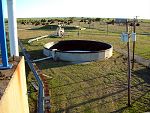
Credits:
SpaceX
The SpaceX engine tests use
facilities on a former Navy
test range in Texas that were also used by Beal
Aerospace. |
|
HS:
Have
you done any test drops of boosters into the water?
Musk: First
one will be on day of launch. We have tested individual components
for salt water tolerance though.
HS:
Thanks very much, Elon, and
best of luck with the Falcon.
The
SpaceX web
site provides details and regular updates
on the Falcon project. The Media section there includes links and
reprints
of the many articles about Mr. Musk and SpaceX in the press.
You can hear interviews with Mr. Musk at
The
Spaceshow from Oct.24.01 and
May.14.03.
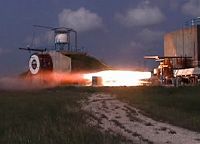
Credits: SpaceX
The Merlin first stage engine at full
thrust.
|




